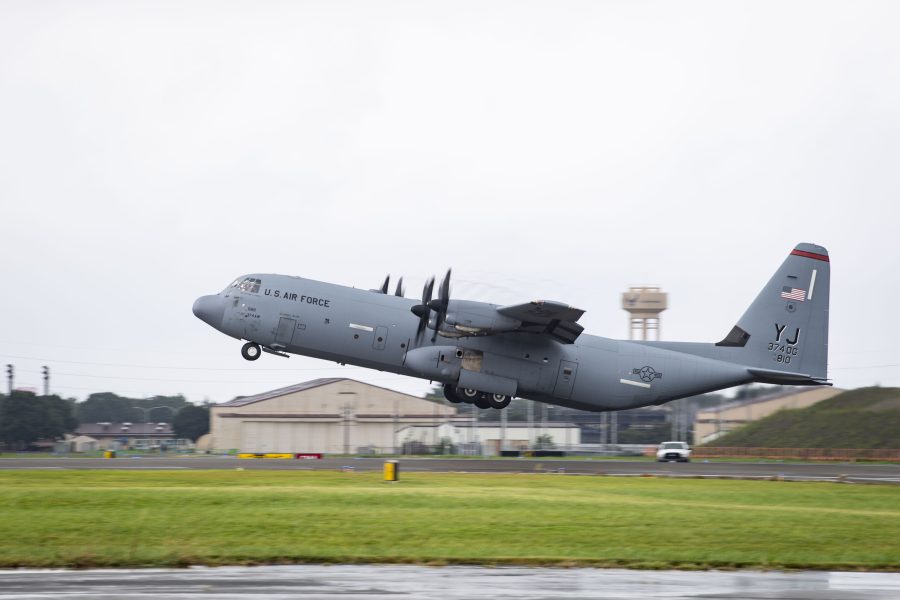Audio of this article is brought to you by the Air & Space Forces Association, honoring and supporting our Airmen, Guardians, and their families. Find out more at afa.org
Yokota Air Base evacuated 11 C-130J Super Hercules in under 24 hours ahead of a typhoon nearing Japan packing the punch of a Category 4 hurricane.
The 374th Airlift Wing flew the cargo aircraft out on Aug 16 out of “an abundance of caution” to maintain combat readiness and protect the aircraft from potential damage.
“For us, launching the fleet wasn’t just about the preventative measures, but that we can demonstrate deterrence to our adversaries,” Technical Sgt. Joshua Rice, 374th Aircraft Maintenance Squadron crew chief, said in a release.
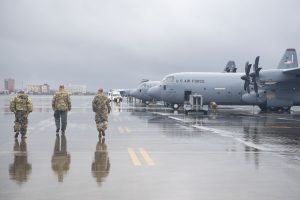
Col. Richard McElhaney, 374th Airlift Wing commander, Col. Brett Cochran, 374th Airlift Wing deputy commander and Chief Master Sgt. Colby Brusch, 374th Maintenance Group senior enlisted leader, approach a U.S. Air Force C-130J Super Hercules at Yokota Air Base, Japan, August 16, 2024. The wing leadership team went out to the flightline to observe aircraft and crews departing station to preserve combat capability amid the approach of Typhoon Ampil. In addition to aircraft generation, Yokota Air Base units also took additional measures to ensure readiness including placing sandbags in areas prone to water pooling and sheltering vehicles and other airframes for protection. (U.S. Air Force photo by Senior Master Sgt. DeAndre Curtiss) 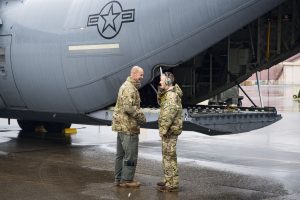
Col. Richard McElhaney, 374th Airlift Wing commander, speaks with a 36th Airlift Squadron crew chief at Yokota Air Base, Japan, August 16, 2024. The wing leadership team went out to the flightline to observe aircraft and crews departing station to preserve combat capability amid the approach of Typhoon Ampil. In addition to aircraft generation, Yokota Air Base units also took additional measures to ensure readiness including placing sandbags in areas prone to water pooling and sheltering vehicles and other airframes for protection. (U.S. Air Force photo by Senior Master Sgt. DeAndre Curtiss)
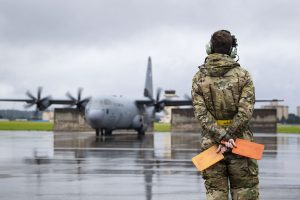
A maintainer assigned to the 374th Aircraft Maintenance Squadron prepares to marshal a U.S. Air Force C-130J Super Hercules at Yokota Air Base Japan, August 16, 2024. At the direction of Col. Richard McElhaney, 374th Airlift Wing commander, the 374th Operations Group in tandem with the 374th Maintenance Group prepared, generated and launched eleven C-130Js in less than 24 hours as a preventive measure to avoid mission degradation due to Typhoon Ampil. In addition to aircraft generation, Yokota Air Base units also took additional measures to ensure readiness including placing sandbags in areas prone to water pooling and sheltering vehicles and other airframes for protection. (U.S. Air Force photo by Senior Master Sgt. DeAndre Curtiss)
Typhoon Ampil swiped eastern Japan on Aug. 16 with strong winds and torrential rain, causing power outage, hundreds of flight and train cancellations, and mandatory evacuations. Tokyo, the nation’s capital, saw flooded streets and fallen trees blocking roadways in the city and nearby prefectures, according to local reports.
Yokota, just 30 miles from Tokyo, is the only U.S. base in Japan with C-130J aircraft and serves as the Air Force’s primary airlift hub in the Western Pacific. The Airmen on site were initially put on ‘BRAVO’ status that signals a heightened state of readiness, and given the green light for the mass deployment of the fleet on the morning of the operation. Under BRAVO alert, aircraft are expected to be ready for departure 3 hours following the alert for C-17, C-130, and KC-10 missions.
“In 25 years of flying, I’ve never seen 100 percent mass generation and execution at this scale,” Col. Richard McElhaney, who took command of the 374th last month, said about the deployment.
The wing did not disclose to where the aircraft were evacuated, but did say the crew prepped the transport planes with maintenance gear to ensure smooth operations off-station and a safe return to Yokota after the typhoon threat passed.
Meanwhile, other aircraft were sheltered in hangars, sandbags were laid in flood-prone areas to protect infrastructure, and vehicles and airframes were tucked away to avoid damage. The base also hosts CV-22 Ospreys, UH-1N Iroquois, and C-12 Hurons.
“Today was easy because of all the work everyone put in, from the aircrews to maintenance and logistics, this showcases what Team Yokota is capable of,” Rice said.
Ampil tracked along Japan’s coast, prompting the evacuation of more than 300,000 residents due to high waves, potential landslides, and increasing rain into Aug. 17. The typhoon had maximum sustained winds of 132 miles per hour and gusts reaching 160 mph, equivalent to a Category 4 hurricane. But with the storm’s center mostly remaining over the ocean, it could weaken to a tropical storm by Aug. 18, and Japan will dodge a worst-case scenario, according to the local authorities. The other two USAF bases in Japan, Kadena and Misawa, are outside the storm’s primary impact zone.
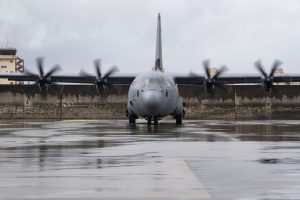
A U.S. Air Force C-130J Super Hercules assigned to the 36th Airlift Squadron prepares to taxi at Yokota Air Base Japan, August 16, 2024. At the direction of Col. Richard McElhaney, 374th Airlift Wing commander, the 374th Operations Group in tandem with the 374th Maintenance Group prepared, generated and launched eleven C-130Js in less than 24 hours as a preventive measure to avoid mission degradation due to Typhoon Ampil. In addition to aircraft generation, Yokota Air Base units also took additional measures to ensure readiness including placing sandbags in areas prone to water pooling and sheltering vehicles and other airframes for protection. (U.S. Air Force photo by Senior Master Sgt. DeAndre Curtiss)
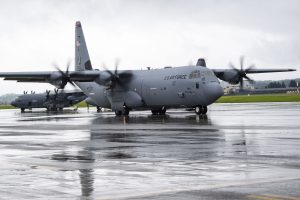
A U.S. Air Force C-130J Super Hercules assigned to the 36th Airlift Squadron taxis before takeoff at Yokota Air Base Japan, August 16, 2024. At the direction of Col. Richard McElhaney, 374th Airlift Wing commander, the 374th Operations Group in tandem with the 374th Maintenance Group prepared, generated and launched eleven C-130Js in less than 24 hours as a preventive measure to avoid mission degradation due to Typhoon Ampil. In addition to aircraft generation, Yokota Air Base units also took additional measures to ensure readiness including placing sandbags in areas prone to water pooling and sheltering vehicles and other airframes for protection. (U.S. Air Force photo by Senior Master Sgt. DeAndre Curtiss)
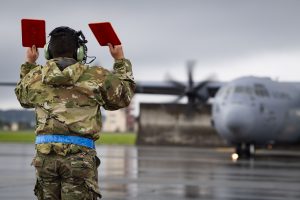
A maintainer assigned to the 374th Aircraft Maintenance Squadron marshals a U.S. Air Force C-130J Super Hercules at Yokota Air Base Japan, August 16, 2024. At the direction of Col. Richard McElhaney, 374th Airlift Wing commander, the 374th Operations Group in tandem with the 374th Maintenance Group prepared, generated and launched eleven C-130Js in less than 24 hours as a preventive measure to avoid mission degradation due to Typhoon Ampil. In addition to aircraft generation, Yokota Air Base units also took additional measures to ensure readiness including placing sandbags in areas prone to water pooling and sheltering vehicles and other airframes for protection. (U.S. Air Force photo by Senior Master Sgt. DeAndre Curtiss)
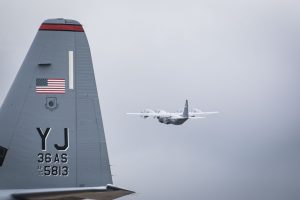
A U.S. Air Force C-130J Super Hercules assigned to the 36th Airlift Squadron takes off from Yokota Air Base Japan, August 16, 2024. At the direction of Col. Richard McElhaney, 374th Airlift Wing commander, the 374th Operations Group in tandem with the 374th Maintenance Group prepared, generated and launched eleven C-130Js in less than 24 hours as a preventive measure to avoid mission degradation due to Typhoon Ampil. In addition to aircraft generation, Yokota Air Base units also took additional measures to ensure readiness including placing sandbags in areas prone to water pooling and sheltering vehicles and other airframes for protection. (U.S. Air Force photo by Senior Master Sgt. DeAndre Curtiss)
Audio of this article is brought to you by the Air & Space Forces Association, honoring and supporting our Airmen, Guardians, and their families. Find out more at afa.org
